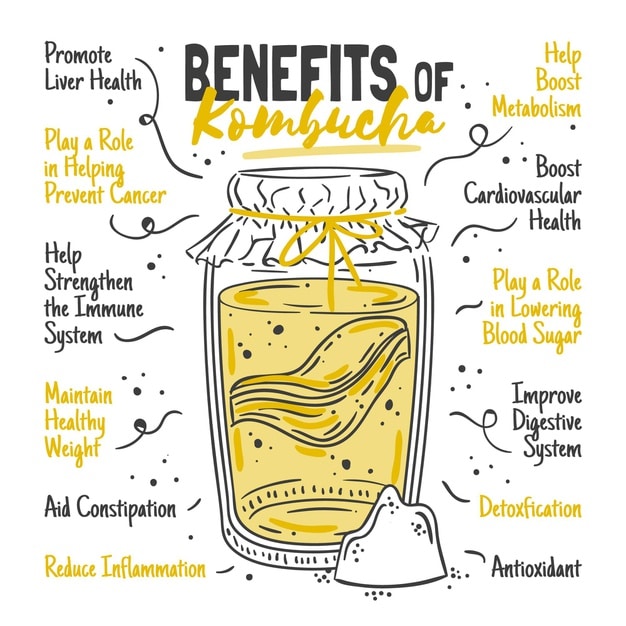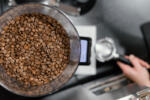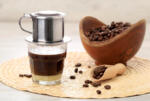Have you ever wondered if you could make kombucha with coffee?
Table Of Contents
−- What is coffee kombucha?
- Is it kombucha coffee or coffee kombucha?
- How is coffee kombucha made?
- Coffee kombucha health benefits
- When making homemade kombucha, there are two main fermentation stages:
- How to make coffee kombucha
- Important factors to consider when making kombucha coffee
- Is kombucha coffee the same as fermented coffee?
- What does coffee kombucha taste like?
- What is the caffeine content of coffee kombucha?
- Is there any alcohol in coffee kombucha?
- How long does coffee kombucha last?
There are few things better than a big pot of coffee in the morning or a refreshing glass of kombucha on a hot day.

But what about having both at the same time?
I like to indulge in this treat on days when I’m feeling sluggish and need a little extra pick me up. It’s a great drink for mornings when you can’t decide between coffee or tea, but want both in one cup.
I’m going to show you how to make a tried and tested Coffee Kombucha that you’re going to love!
What is coffee kombucha?
The world is essentially divided into two categories: coffee drinkers and tea drinkers. Both are constantly looking for new ways to use, mix, and fine-tune their preferred caffeine source. Kombucha (pronounced: kom-BOO-cha.) could be deemed a specialty tea drink, while coffee kombucha would be its counterpart for coffee lovers. As the name suggests, coffee kombucha is a variation on regular kombucha in which brewed coffee is fermented instead of black or green tea.
Is it kombucha coffee or coffee kombucha?
If you look around the internet, you’ll notice that some people talk about coffee kombucha, while others talk about kombucha coffee. Both are discussing the same topic. Which is the correct answer?
That is, of course, dependent on your point of view. You might think it should be called coffee kombucha if you like tea because it’s a coffee-infused version of tea kombucha.
What matters is that it’s kombucha, not that it’s made with coffee.
On the other hand, a coffee drinker would probably argue that it should be called kombucha coffee and that the fermentation process has altered brewed coffee.
Whatever you want to call it. It’s a very special drink with a distinct flavor—some call it an acquired taste—and health benefits that will convert even the most hesitant drinker into a fan.
How is coffee kombucha made?

Fermentation is how small microorganisms such as bacteria, fungi, or yeasts break down large food molecules into smaller compounds that they can use for growth and energy. In kombucha, fermentation is accomplished by acetic bacteria and certain types of yeast, which consume the sugar in the sweetened solution and produce acid compounds such as acetic acid (the same acid found in vinegar) and gases such as carbon dioxide.
The fermenting microorganisms are incorporated into the solution in the form of a SCOBY, a semi-solid, gelatinous-looking disc. SCOBY stands for Symbiotic Colony Of Bacteria and Yeasts, and as the name implies, it is a colony of different types of microorganisms such as yeasts and bacteria living together in harmony to fulfill each other’s needs. That is why it is referred to as symbiotic.
Consider a SCOBY to be a small, secluded city where different people perform different tasks, each being important to the city’s survival. Yeasts in SCOBYs consume sugars and convert them to alcohols, which are then consumed by bacteria, which convert the alcohols formed by the yeasts into organic acids such as acetic acid. There are numerous other byproducts of the fermentation process that contribute to the taste and flavor of fermented foods and beverages.
Coffee kombucha is created by incubating a SCOBY in a sweetened coffee solution and then fermenting it. That sounds simple enough, and it is, but there are a few things you should keep in mind:
- Because a SCOBY is a living colony of microorganisms, if it is overheated, the bacteria and yeasts will die, rendering the SCOBY useless.
- If you’re a seasoned kombucha maker, you might think that making coffee kombucha is the same as making tea kombucha. However, there are a few major differences. The most significant distinction is that coffee is ordinarily more acidic than tea, so making coffee kombucha does not necessitate the addition of vinegar to the mix. Second, coffee kombucha is fermented twice, rather than once, as regular kombucha, for a better taste and an extra sparkling kick.
Coffee kombucha health benefits

Even with standard kombucha, coffee kombucha seems to provide all of the essential health benefits of all cultured foods and much more. Among the many advantages of drinking coffee kombucha are:
Packed with probiotics
Coffee kombucha is high in probiotics, which are good microorganisms that live in your body and help you in various ways. This excellent review article outlines the major health benefits of probiotics, which include:
- Probiotics enhance intestinal health by assisting in the breakdown of food molecules into smaller compounds that are simpler for the body to digest and absorb.
- Probiotics can help prevent cancer.
- Probiotics can significantly minimize or treat antibiotic-induced diarrhea as well as other types of diarrhea.
- Probiotics lower blood cholesterol levels.
- Probiotics boost the immune system, assisting your body in fighting off and preventing diseases caused by harmful pathogenic microorganisms.
Coffee kombucha contains probiotics, which have a plethora of health benefits of their own.
Lower fluoride concentration
Coffee kombucha has a lower fluoride concentration than regular kombucha. While more research into how fluoride affects the body is needed, the current knowledge base suggests that fluoride is linked to diabetes and cancer. Fluoride is proven to cross the blood-brain barrier, one of the body’s main protective barriers, and can enter the body of an unborn baby through the placenta.
Much less caffeine
Coffee kombucha is largely decaffeinated, so it can be consumed at any time of day by coffee lovers who cannot tolerate caffeine. We’ll explain why coffee kombucha contains so little caffeine further down.
This is in addition to the health benefits of regular coffee, such as the high antioxidant content, lower blood pressure, and increased energy. You’ll understand why coffee kombucha is rapidly becoming a popular beverage.
If you would like to get far more from your coffee kombucha, try brewing it with kopi luwak (also known as civet coffee or cat poop coffee), which has far more health benefits than normal coffee.
When making homemade kombucha, there are two main fermentation stages:
- First Fermentation: This is the stage at which sweet tea is converted into tart and tasty kombucha.
- Second Fermentation: When you flavor and carbonate the kombucha with flavors and sugars before bottling it.
Coffee should not be used in the first fermentation. Coffee contains many oils, which have a higher chance of going rancid and ruining your batch. Instead, we’ll employ coffee as a flavor in the second fermentation, which denotes that you’ll need to have finished the first fermentation and have some ready-to-carbonate kombucha!
How to make coffee kombucha
Have you ever wondered if you could make kombucha with coffee? I’m going to show you how to make a perfect Coffee Kombucha that you’re going to love!
Ingredients
- ¼ to ½ cup strong coffee chilled (our best cold brew coffee beans list)
- ½ gallon kombucha from a first fermentation this is not store-bought
- 2 teaspoon sugar
- Optional flavors: 12 tablespoon vanilla extract, two tablespoons unsweetened cocoa powder
Instructions
- Fill fermentation bottles evenly with coffee, sugar, and optional flavors. Fill the container halfway with the first fermentation kombucha, leaving 1–2 inches at the top free.
- Ferment in a dark, room-temperature area for 3 to 10 days, or until the desired level of carbonation is reached. This process will be faster in warmer climates, while in cooler climates, it will be slower.
- Chill in the refrigerator before serving. It can be kept in the fridge for several weeks if tightly sealed.
Tips & tricks
- How much coffee do you drink? A 14 cup of coffee will provide a hint of coffee flavor, whereas a ½ cup will be more noticeable. I prefer ½ cup!
- Pressure gauge: If it is your first time brewing, a plastic water bottle can serve as a gauge. Fill a single-use plastic bottle halfway with kombucha (leaving 2 inches empty at the top). When this bottle hardens, you’ll know the glass bottle is also ready. This will assist you in determining how quickly kombucha brews in your climate and help you avoid bottle explosions.
Nutrition information
- Serving size: 1 cup (depends on the extent of fermentation)
- 12g Carbohydrates (4 percent )
- Sodium (mg): 10mg
- Calories: 50 kilocalories (3 percent )
- 0g fat
- Protein (g): 0g
- Saturated Fat (g): 0g
- 10g sugar (11 percent )
Important factors to consider when making kombucha coffee
- Coffee has a high acidity level. As a result, no starter kombucha tea or vinegar is required.
- Make use of an extra kombucha culture. Once a culture has been used to make kombucha coffee, it shouldn’t be used to make kombucha tea.
- Because coffee consists of oils, it is susceptible to rancidity. Keep a close eye on your batch and cap fermentation time to only what is required to achieve the desired flavor. Never drink kombucha that tastes, looks, or smells bad.
- Coffee will typically stain the kombucha culture, resulting in brown spots on the scoby.
- Kombucha coffee should always be served cold or at room temperature. The majority of the beneficial yeasts and bacteria will be destroyed by heating.
Is kombucha coffee the same as fermented coffee?
Coffee kombucha is fermented coffee, but when you go to the store, and the grocer presents to you fermented coffee, that is not coffee kombucha. The term “fermented coffee” refers to the ground or roasted coffee that has been fermented before roasting, most commonly in the parchment coffee or green coffee stages of coffee production. On the other hand, coffee kombucha is coffee that’s been fermented after it has been brewed.
Another significant distinction is that, whereas nearly all of the probiotics present after the fermentation process in “fermented coffee” are destroyed during the roast, leaving only the beneficial compounds derived from the fermentation itself, coffee kombucha retains all of the healthy probiotics. That implies your coffee kombucha is ready to provide the extra health boost that cultured foods are known for.
What does coffee kombucha taste like?
Many people believe that kombucha, in general, is an acquired taste because fermentation yields acetic acid as a byproduct. Some people even compare regular kombucha to fermented apple cider vinegar. However, most people dislike kombucha because they are not yet accustomed to the taste despite its health benefits. On the other hand, coffee kombucha has the added benefit of adding that roasted flavor to the mix. Because coffee is naturally acidic, the additional acidity derived from fermentation is nothing new to us, coffee connoisseurs.
What is the caffeine content of coffee kombucha?
Many organic compounds in the sweetened coffee solution, including caffeine, are broken down by the SCOBY microorganisms. This means that because fermentation naturally decaffeinates coffee, coffee kombucha contains very little caffeine.
There has been very little research on the caffeine content of coffee kombucha, but some reported studies with regular kombucha can provide guidance.
Black tea contains more caffeine than coffee. When you brew regular kombucha from black tea, the resulting drink contains about 8-14mg of caffeine per 8oz serving. Because coffee contains less caffeine, to begin with, it stands to reason that coffee kombucha contains even less caffeine. To give you a better idea, a Starbucks decaf espresso contains approximately 6-7mg of caffeine per 8oz serving (yes, believe this or not, decaffeinated coffee still contains caffeine), so you can expect your batch of coffee kombucha to contain even less caffeine than your average decaf coffee.
Make your coffee kombucha with kopi luwak, which has much less caffeine than regular coffee, and you’ll have a sparkling, refreshing drink with the delicious flavor of one of the best coffees available. Still, it’s caffeine-free, so that you can drink it at any time of day.
Is there any alcohol in coffee kombucha?
Yes, but only very slightly. The yeasts in the SCOBY (typically a type of yeast called Saccharomyces) ferment sugars and convert them to ethanol (ethanol is the chemical name of the alcohol present in alcoholic beverages). A large portion of the ethanol produced is used by the other bacteria in the SCOBY and oxidized (converted) into acetic acid (the acid found in vinegar). As such, in the end, the only ethanol left in the kombucha is what the bacteria left behind.
According to this study, the alcohol content of kombucha skyrockets during the first days of fermentation and peaks at around ten days. Kombucha has an alcohol content of only 0.5 percent at its peak, which is about one-tenth of a regular beer. Some brands of regular kombucha are intentionally fermented to produce a higher alcohol content. Nonetheless, they are available in liquor sections of supermarkets and stores.
How long does coffee kombucha last?
There have been no published studies on the life span of coffee kombucha, so more research is needed. Because it is a living beverage, we strongly advise that you store your coffee kombucha in the refrigerator after the second fermentation to prevent further fermentation. This does not completely stop the fermentation—it only delays it —so after about a week, your kombucha may become over-fermented. When the natural oils in coffee ferment, they turn into sour-tasting organic acids, so don’t leave your coffee kombucha for more than 7-10 days.
Disclaimer: This post contains affiliate links, which means I may receive a small commission, at no extra cost to you, if you make a purchase using these links. Remember to support us by purchasing through the Amazon/Walmart/Impact Radius links provided. Last update on 2024-04-25 / Affiliate links / Images from Amazon Product Advertising API
Disclosure: No compensation or free products were received in exchange for writing this review.

Editorial Staff
The editorial staff at Crazy Coffee Crave is a team of coffee enthusiasts & Baristas who enjoy the one thing we all think about as soon as we get up in the morning. Trusted by thousands of readers worldwide.












